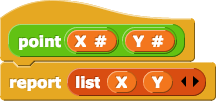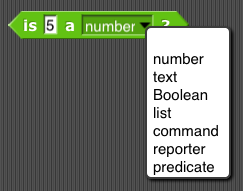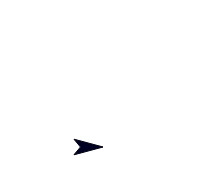Gamal joins Betsy and Alphie's discussion about using a list of coordinates to make a drawing of a letter.

Gamal: I think you had trouble finishing that last script because those
item of blocks get confusing with lists inside lists.Betsy: Yeah, the expressions like  get confusing fast!
get confusing fast!
 get confusing fast!
get confusing fast!Gamal: Well, we could define a new data type called ().png) that contains an x-coordinate and a y-coordinate.
that contains an x-coordinate and a y-coordinate.
().png) that contains an x-coordinate and a y-coordinate.
that contains an x-coordinate and a y-coordinate.Gamal's idea is called data abstraction: creating a new abstract data type so that the detailed representation of the type is hidden from its users. In this case, users of points don't have to know that they're represented as lists.
Gamal has built this block:


Betsy: That block is trivial; it isn't going to make the rest of the program any shorter.
Point does the same thing as list!Gamal: But it is going to make it easier to think about. Now, a list of points will actually look like a list of points:

Gamal's ().png) block is called the constructor for the
block is called the constructor for the
().png) block is called the constructor for the
block is called the constructor for the point abstract data type because it constructs (and reports) the list of assigned inputs (in this case, the x and y coordinates for a point).
Betsy: Hmmm... So we could also make  instead of
instead of  , which was confusing too.
, which was confusing too.
X coordinate and Y coordinate blocks so that the drawing script would have things like  instead of
instead of  , which was confusing too.
, which was confusing too.
Betsy's two other blocks: 



Betsy's two blocks  and
and  are called the selectors for the
are called the selectors for the
 and
and  are called the selectors for the
are called the selectors for the point abstract data type because they each select one component of a point.
 block that draws any shape based on a list of coordinates using the constructor and selectors designed by Gamal and Betsy, respectively.
block that draws any shape based on a list of coordinates using the constructor and selectors designed by Gamal and Betsy, respectively. shows that a list value is expected. This animation shows you how to specify the list input type:
shows that a list value is expected. This animation shows you how to specify the list input type: hides all the complexity of the lists of coordinates used to draw the shapes.
hides all the complexity of the lists of coordinates used to draw the shapes.